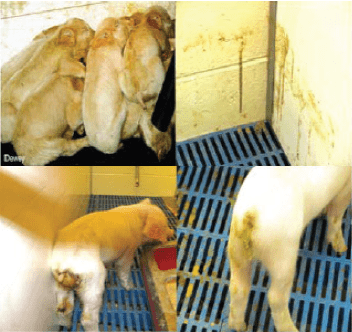Neonatal Pig Diarrhoea is one of the leading causes of morbidity and mortality in neonatal pigs. Diarrhoeal disease in neonates is often sudden in onset and causes a rapid decline in clinical condition as the pig becomes dehydrated and develops systemic infections.
Thus prevention, early identification and immediate initiation of supportive care and treatment in neonatal diarrhoea cases are critical.
Hence, the understanding of the basic aspects of neonatal diarrhoea in pigs which include clinical signs, pathogenesis, diagnosis and control strategies would be highly advantageous for every pig farm owners and associates.
Clinical Signs of Neonatal Pig Diarrhoea
The most common clinical signs observed with neonatal diarrhoea include water to pasty stools, lethargy and dehydration. Diarrheic stools are often observed along the walls, flooring and on other pigs.
However, at times diarrhoea can be difficult to appreciate, especially if the diarrhoea is watery and may not be visible in the pens. Therefore, careful examination of both the piglets and the pens is important to identify diarrhoeal disease.
Additional clinical signs to look for are wet backsides, reddened perineal area and huddling. A characteristic odor from greasy, scouring pigs can also be noted when walking through a room.
Read Also: Types of Pig Feeds and When to Feed Each
Pathogenesis
The majority of neonatal diarrhoea is caused by infectious pathogens which include bacterial, viral, and parasitic organisms.
The most common infectious agents responsible for neonatal diarrhoea are listed below:
The age at onset is helpful in ruling out some infectious causes of diarrhoea. For example, Clostridium perfringens causes diarrhoea predominantly in the first week of life and becomes much less common after 7 days of age.
Coccidiosis, caused by isospora suis, does not affect pigs younger than 6 days of age. However, other pathogens such as E.coli (K88) and Transmissible gastroenteritis (TGE) can cause disease in any age group, but the disease is more severe in neonatal animals.
Common Clinical Signs Associated with Neonatal Diarrhoea in Piglets

- Watery to pastry stools
- Lethargy
- Wet backsides
- Dirty pens and pigs
- Reddened perineal area
- Huddling
Diagnosis
Although age at onset, morbidity, mortality and past history on the farm can help develop a presumptive diagnosis, necropsy and sample submission to a diagnostic laboratory is necessary to confirm the causative agent and to aid the appropriate treatment and control programs.
Prevention/Treatment
Many of the pathogens causing diarrhoea in neonatal pigs are normal inhabitants of the gastrointestinal tract and do not cause disease in healthy piglets.
This is due to innate defense mechanisms present in the healthy piglet. However, when defense mechanisms are compromised, infectious pathogens can take advantage of this and cause disease.
There are several stress-related factors in swine production that contribute to impaired defense against pathogens and thus predispose piglets to infectious diarrhoeal disease.
These include unsanitary environment, extreme cold or large fluctuations in the pen temperature, stress, and inadequate intake of colostrums and / or lack of protection of maternal antibodies transferred from the sow.
Also, with regards to the cleanliness of the environment, special adherence to All-In, All-Out pig flow is critical in the prevention of neonatal diarrhoea.
This includes washing rooms with soap/degreaser to remove biofilms, appropriate disinfection, and complete drying of rooms in between pig turns. For example, loading pigs into a wet farrowing room that has been hastily cleaned will increase the likelihood of neonatal diarrhoea issues.
As mentioned previously, inadequate barns temperature control is an important predisposing factor for neonatal diarrhoea therefore provision of supplemental heat for at least the first 3days is necessary due to the piglets’ inability to self regulate their body temperature.
Another factor influencing the susceptibility of piglets to neonatal diarrhoea is sow parity – parity is the number of times a female animal has given birth.
Litters from low parity dams are more susceptible to infectious diarrhoea due in large part to the lower passive immunity received from naïve dams.
Read Also: The Different Species of Pig
Sow vaccine programs have proven effective in the prevention and control of neonatal diarrhoea such as E.coli and Clostridial disease. Sows are typically vaccinated twice during gestation to enhance the passive transfer of protective antibodies from the sow to the piglet through colostrum.
Antimicrobials can also be included in sow rations in efforts to reduce the number of infectious pathogens shed in sow feaces and therefore limit the environmental pathogen exposure to piglets.
Once diarrhoeal disease has begun, treatments often include antibiotics and supportive therapy including keeping pigs warm with heat lamps and hydrated with sugar-based electrolyte solutions provided in the water.
However, it is important that treatments are based on a proper diagnosis and veterinary insight to ensure appropriate treatment and a successful outcome.
In conclusion, neonatal scours continue to be a major cause of neonatal morbidity and mortality. Careful attention to both the piglets and environment is necessary for the timely identification of clinical disease and initiation of treatment.
The impact of diarrhoeal disease can be largely reduced by eliminating predisposing stressors and instituting preventative and control programs.
Read Also: Complete List of Anti-Inflammatory Foods you Should Know About

